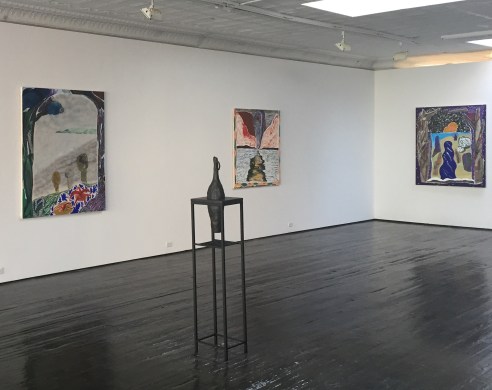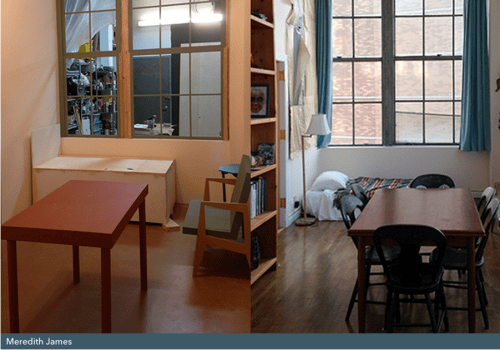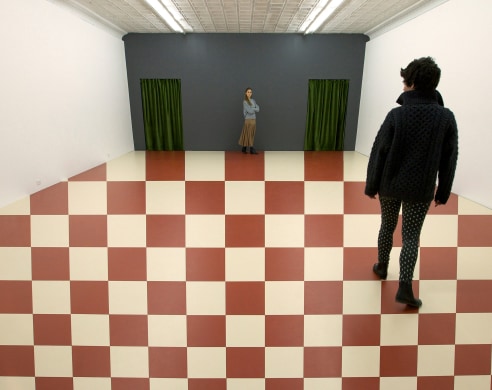
Meredith James to participate in Catalyst at the Queens Museum
Opening reception, October 18

Three distinctive New York artists have each been awarded a sizable grant from the Jerome Foundation that aims to encourage and foster their professional acumen and creative development. The fellowship is structured to include intensive institutional support from the Museum on professional, technical, and philosophical levels, through a close working relationship with QM curator, Hitomi Iwasaki, and other museum staff members with diverse specializations. In this way, the fellowship aims to provide an optimum opportunity for each artist to expand their vision and practice.
Working in video, sculpture, and theater, Meredith James (b. 1982, New York, NY) explores mechanisms of perception, and the fallibility of observation, to reveal the surprising and disorienting potential in the world around us that is both narrative and physical. Kameelah Janan Rasheed (b.1985, East Palo Alto, CA) is an artist-archivist who works in the space between visual and literary arts to explore how we construct narratives around our personal and social histories. Working with found and original materials, she creates zines and books as well as archive-like installations that map conversations between texts, ephemera, personal memorabilia, and photography. Casey Tang (b. 1984, New York, NY) engages and explores diverse disciplines including ecology, musicology, and narratology in his pursuit of various cultural norms within and outside of western worldviews. Through geographic and chronological investigation of human experiences and material cultures, Tang creates luminal areas to recontextualize and compare systems of cultures in his multi-disciplinary artistic production that include video, sound, and graphic and sculptural installation.
Meredith James’ Mobius City is staged as a life-size replica of her 10th floor apartment in East Village erected inside the museum’s gallery space. The interior of the apartment is designed to look the way an apartment inside of one of the tiny buildings in the Queens Museum’s Panorama of the City of New York might look; James’ model share the same simplified style, blown-up to human scale. Inside, a video plays a montage of scenes of the Queens Museum’s Panorama, along with views from the World Trade Center and her apartment window. James weaves this footage into a looping narrative exploring the optical relationship between the real city and its double—the miniature universe of the Panorama— in a hypnotic interplay of scale and illusion.
Kameelah Janan Rasheed’s Source Material for a Poem I’ve Been Trying to Write about Casual Superlatives, National Progress and Palate Cleansers explores her interest in poetry, improvisation, and narratives of progress, through a hybrid visual and literary art practice. Rasheed’s sprawling installation sutures together wide ranging “concentrated language” including both self-authored and found materials such as aphoristic posters, short poems, micro-fiction, book excerpts, and dictionary entries along with photographs and fabric. Her process of researching, digging through archives, and repurposing texts through alliterative games and constricted writing techniques, is rooted in the work of poets like Harryette Mullen. Rasheed will also lead a zine-making workshop—as an extension of her archiving practices—in collaboration with the Queens Museum’s New New Yorkers program that offers numerous workshops, often instructed in various languages.
Casey Tang’s latest project was recently filmed in the regions along the Yangtze River in China, and the Mississippi River in the States. It is a portrayal of the trajectory of industrial capitalism, from the relics of the boom-to-bust cities in America, to the giant hi-rises in newly urbanizing China. The work is scored by a guitar tune that subtly transitions from that of a guqin (the oldest guitar-like Chinese instrument) into American guitar stylings, including country, blues, jazz, electronic, and/or ambient. The exhibition also features First Sounds (2012), a piece Tang created in collaboration with astronomer Mark Whittle, who used computer calculations rooted in the Cosmic Microwave Background data to recreate the fundamental tone and higher harmonics of the sound of the early universe. Dr. Whittle translated these sounds into the human range of hearing by upping the frequency by fifty octaves.
The Jerome Foundation Fellowship is a program that is designed to support emerging artists in New York City area by providing financial and institutional supports for new production. The first season‘s awardees, Meredith James,Kameelah Janan Rasheed, and Casey Tang, are selected by panels including Naomi Beckwith (Museum of Contemporary Art, Chicago) and Herb Tam (Museum of Chinese in America, NYC), and Queens Museum curator Hitomi Iwasaki.
